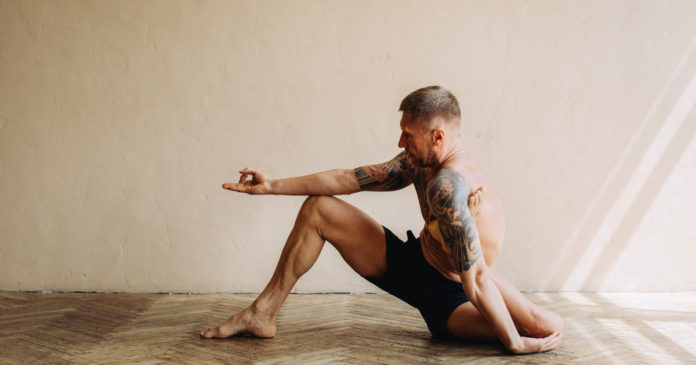Can yoga build muscle? Here’s where we get into the fascinating connection between yoga and strengthening your muscles. Yoga has long been associated with relaxation and meditation, but it’s now becoming regarded as an effective means of boosting strength and muscular development.
Can yoga build muscle? Despite what the general public believes, yoga is not only for those who want to be flexible and relaxed. As a matter of fact, adding certain yoga postures to your workout regimen may enhance conventional strength training activities and promote general muscular growth.
We will explore the several ways that yoga may help your muscles in this part. We’ll explore the special benefits that practicing yoga offers to your quest for developing a stronger body, from increasing muscular endurance and flexibility to fostering good alignment.
Can yoga build muscle? Join us as we examine the intriguing relationship between yoga and attaining maximum muscular growth, regardless of your level of experience with weightlifting and desire to add variety to your training plan.
The Science Behind Yoga’s Ability to Build Muscle
Can yoga build muscle? Although yoga is often linked to relaxation and flexibility, it may also lead to muscular growth. The unique combination of bodyweight resistance, isometric holds, and stretching that constitutes yoga is scientifically responsible for its capacity to increase muscle mass and strength.
There are some yoga positions that work especially well for building muscle and targeting certain muscle groups. Several muscles are worked at once in poses like Plank, Chair Pose, and Warrior II, which gives the body a taxing exercise. Can yoga build muscle? Over time, the strength and stability required for these postures will result in greater muscle activation.
Research indicates that practicing yoga may promote the production of proteins in the muscles as well as to the exertion of the postures. Since it includes the production of new proteins that rebuild and repair muscle fibers after exercise, protein synthesis is a crucial step in the development of muscle. Through persistent yoga practice, one may assist their muscle-building objectives by boosting protein synthesis.
It is noteworthy that while yoga may aid in the growth of muscles, it might not offer the same degree of hypertrophy as conventional weightlifting activities. But adding yoga to a well-rounded workout regimen may improve balance, strength, and flexibility as well as provide a novel way to gain lean muscle mass.
Can yoga build muscle? Therefore, adding focused yoga postures to your exercise program can be something to think about, whether you’re wanting to enhance your weightlifting practice or just explore a new approach of gaining strength.
How Yoga Poses Target Different Muscles in the Body
Yoga is much more than simply developing your flexibility and inner serenity. Additionally, yoga positions may target certain muscles in your body, which can help you gain strength and enhance your general health.
There are a few yoga positions that might be beneficial for those who want to improve their upper body. Positions such as plank posture, chaturanga, and downward dog work your shoulders, arms, and chest. These postures enhance stability and posture in addition to increasing strength.
Can yoga build muscle? Yoga is a great method to strengthen your core muscles. PExercises that strengthen the core include twists, boat posture, and variations on plank stance. These poses work the muscles in the abdomen. In addition to helping with back pain relief, a strong core is necessary for preserving balance throughout other physical activity.
Leg muscles may be strengthened with yoga as well. Asanas like chair pose, crescent lunge, quadriceps, hamstrings, and crescent lunge contract the buttocks, calf, and quadriceps. By doing these positions on a regular basis, one may strengthen and stabilize their legs.
That being said, adding certain yoga postures to your regimen may help you achieve your fitness goals, whether they be to strengthen your legs, core, or upper body.
The Benefits of Combining Yoga with Traditional Strength Training Exercises
For those who like fitness, combining yoga with conventional strength training routines may have several advantages. Weightlifting is primarily focused on increasing the size and strength of your muscles; yoga is a supplemental exercise that improves your total physical health.
Can yoga build muscle? Improved muscle recovery is one of the main benefits of combining yoga with weight training. Stretches and yoga postures ease tension and discomfort in the muscles, accelerating recovery time between strenuous weight lifting workouts. You may reduce your chance of injury and maximize your body’s capacity for muscle healing and rebuilding by including yoga into your program.
Additionally, yoga improves stability, balance, and flexibility—all crucial elements for weightlifters looking to increase their performance. Yoga’s numerous positions focus on different muscle groups, which improves general awareness of one’s body and control. By improving form during weightlifting activities, this greater stability lowers the risk of strain or injury.
Furthermore, combining yoga with conventional weight training routines fosters awareness and mental concentration. Deep breathing exercises that ease mental tension and promote mental calmness are encouraged by yoga. This mental clarity may be quite helpful while doing difficult exercises or lifts.
Can yoga build muscle? To sum up, there are many benefits of integrating yoga with conventional strength training activities, including better muscular recovery, increased flexibility, stability, equilibrium, mental clarity, and mindfulness. You may acquire a comprehensive approach to staying in shape that improves your mental and physical health by combining both techniques into your workout regimen.
Can Yoga Build Muscle? Tips For Using Yoga To Build Muscle Effectively
Can yoga build muscle? There are certain important things to consider if you want to use yoga as an effective method of building muscle. First and foremost, it’s crucial to think about how often you practice yoga. Although yoga is mostly associated with relaxation and flexibility, you may encourage the development of your muscles by including strength-building postures in your practice. Try to commit at least two or three yoga sessions a week to strengthening your body.
Can yoga build muscle? For the purpose of building muscle, adding resistance to your yoga practice may be quite helpful in addition to frequency. This may be accomplished by practicing more difficult versions of common poses or by adding props like blocks and straps to accentuate certain positions. By increasing the resistance, you give your muscles one more task to do, which encourages muscular development and strength.
Finally, incorporating the idea of progressive overload into your yoga poses might help you grow more muscle. Progressive overload refers to progressively raising your muscles’ demands over time. Can yoga build muscle? As your practice develops, you may do this by holding positions for longer periods of time, doing additional repetitions or collections, or experimenting with more difficult variants of poses.
Can yoga build muscle? You may utilize yoga as an excellent method to increase muscle mass and improve general strength and fitness levels by paying attention to frequency, adding resistance, or applying progressive overload.
Conclusion: Embrace the Power of Yoga to Enhance Your Muscle Building Journey
Can yoga build muscle? In conclusion, you can significantly improve your muscle-building journey by accepting the power of yoga. You can optimize the advantages of yoga for muscle building by knowing when to include it into your program. Furthermore, using props or modified postures to provide resistance to your yoga practice may assist to develop and test your muscles.
Can yoga build muscle? Finally, using the progressive overload concept in yoga poses enables you to gradually challenge yourself and promote muscular development. Therefore, don’t undervalue the role that yoga may play in your fitness path. It’s not only about relaxation and flexibility; it’s also about developing strong, toned muscles. Accept yoga as a useful tool for reaching your fitness objectives!









